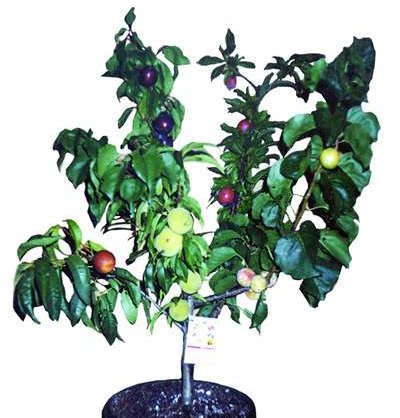
Most
big fruit tree orchards use grafted trees to combine a sturdier trunk
and root plant with delicate branches that produce tasty and consistent
fruit. A long-dead fruit tree can keep bearing fruit from branches
attached to a different trunk. And it is possible to graft several
different kinds of fruit branches onto the same tree!
Grafting
unites the tissues of two or more plants so that they grow and function
as a single plant. One plant in the graft is called the rootstock,
selected for its healthy or hardy root system. The other plant or
plants, chosen for their fruit, flowers or leaves, are known as scions.
You can join a scion to a rootstock in many different ways. In one of
the most common techniques, you remove a branch from a plant whose fruit
you want to reproduce and cut the broken end of the branch into a
V-shape not unlike the reed for a woodwind. Shaving the scion in this
way exposes its vascular cambium—a ring of plant tissue full of dividing
cells that increase the branch’s girth. Once the scion is ready, you
slice lengthwise into a branch on the rootstock—exposing its vascular
cambium—and wedge the scion into the cleft. Successful grafting requires
placing the vascular cambia of both the rootstock and scion in close
contact. Another grafting method involves cutting small pockets between
the rootstock’s bark and cambium and slipping scions into those pouches.
To seal the deal, you bind the scion and rootstock with a rubber band,
tape, staples, string or wax.
Ferris Jabr at
Scientific American goes on to explain what happens inside the branch as
grafting takes hold. But you don't have to do it yourself. He also has
links to several nurseries that sell fruit salad trees for your
backyard.
More
 Most
big fruit tree orchards use grafted trees to combine a sturdier trunk
and root plant with delicate branches that produce tasty and consistent
fruit. A long-dead fruit tree can keep bearing fruit from branches
attached to a different trunk. And it is possible to graft several
different kinds of fruit branches onto the same tree!
Most
big fruit tree orchards use grafted trees to combine a sturdier trunk
and root plant with delicate branches that produce tasty and consistent
fruit. A long-dead fruit tree can keep bearing fruit from branches
attached to a different trunk. And it is possible to graft several
different kinds of fruit branches onto the same tree! 
No comments:
Post a Comment